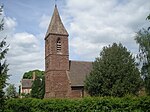
Newport is a market town in the borough of Telford and Wrekin in Shropshire, England. It lies 7 miles (11 km) north-east of Telford town centre, 12 miles (19 km) west of Stafford, and is near the Shropshire-Staffordshire border. The 2001 census recorded 10,814 people living in the town's parish, which rose to 11,387 by the 2011 census.

Baschurch is a large village and civil parish in Shropshire, England. It lies in the north of Shropshire. The village had a population of 2,503 as of the 2011 census. Shrewsbury is to the south-east, Oswestry is to the north-west, and Wem is to the north-east of Baschurch. The village is also close to Ruyton-XI-Towns.

Wem is a market town and civil parish in Shropshire, England, 9 miles (14 km) north of Shrewsbury and 9 miles (14 km) south of Whitchurch.
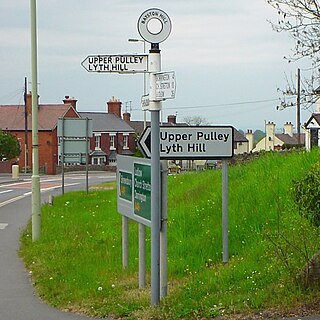
Bayston Hill is a village and civil parish in Shropshire, England. It is 3 miles (5 km) south of the county town Shrewsbury and located on the main A49 road, the Shrewsbury to Hereford road.
High Ercall, also known in the past as Ercall Magna, is a village in the borough of Telford and Wrekin and ceremonial county of Shropshire, England. The civil parish is still called Ercall Magna, and had a total population of 1,679 at the 2001 census, reducing to 1,639 at the 2011 census. The parish includes the villages of Rowton, Ellerdine and Cold Hatton, and a number of hamlets including Cotwall, Osbaston, Poynton and Roden.

Condover is a village and civil parish in Shropshire, England. It is about 5 miles (8 km) south of the county town of Shrewsbury, and just east of the A49. The Cound Brook flows through the village on its way from the Stretton Hills to a confluence with the River Severn. Condover is near to the villages of Dorrington, Bayston Hill and Berrington. The population of the Condover parish was estimated as 1,972 for 2008, of which an estimated 659 live in the village of Condover itself. The actual population measured at the 2011 census had fallen to 1,957.

Upton Magna is a village and civil parish in Shropshire, England. Nearby are the villages of Uffington, Rodington and Withington, as well as the wooded Haughmond Hill. The nearest town to Upton Magna is Shrewsbury, just 2.4 miles (3.9 km) to the west.
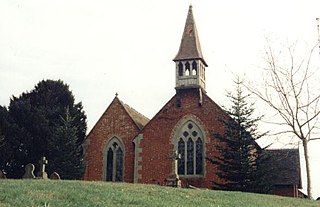
Rodington is a village in Shropshire, England. Situated between the towns of Wellington and Shrewsbury it lies on the relatively level Shropshire plain and just within the borough of Telford & Wrekin.
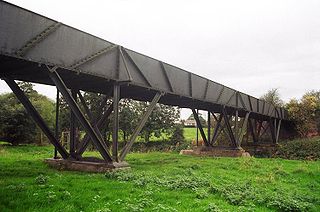
The Shrewsbury Canal was a canal in Shropshire, England. Authorised in 1793, the main line from Trench to Shrewsbury was fully open by 1797, but it remained isolated from the rest of the canal network until 1835, when the Birmingham and Liverpool Junction Canal built the Newport Branch from Norbury Junction to a new junction with the Shrewsbury Canal at Wappenshall. After ownership passed to a series of railway companies, the canal was officially abandoned in 1944; many sections have disappeared, though some bridges and other structures can still be found. There is an active campaign to preserve the remnants of the canal and to restore the Norbury to Shrewsbury line to navigation.

Longdon-Upon-Tern is a village in east central Shropshire, England. It is in the unitary district of Telford and Wrekin, and is approximately 11 kilometres (6.8 mi) east of Shrewsbury and 11 kilometres (6.8 mi) north-west of Telford. Longdon-Upon-Tern is situated on the River Tern, a tributary of the River Severn.
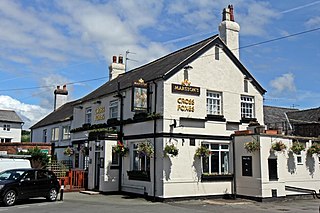
Gobowen is a village in Shropshire, England, about 3 miles north of Oswestry. The population according to the 2011 census was 3,270.
Budbrooke is a village and civil parish in the Warwick district of Warwickshire, England. It is 3 miles west of Warwick and according to the 2001 census the parish had a population of 2,319, reducing to 1,863 at the 2011 Census. Most of the population of Budbrooke live in Hampton Magna, a housing estate built in the late 1960s, with other smaller settlements in Budbrooke Village and Hampton on the Hill.

Harley is a village and civil parish in the English county of Shropshire. The population of the civil parish at the 2011 census was 163.
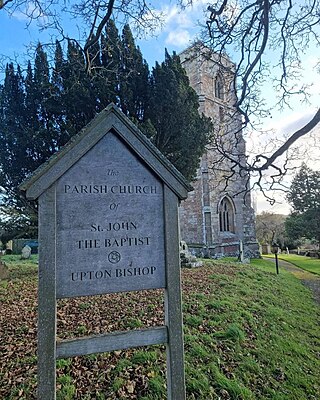
Upton Bishop is a small village in Herefordshire, England. The population of the village at the 2011 census was 602.

Stapleton is a village and former civil parish, now in the parish of Condover, in Shropshire, England. It neighbours the villages of Exfords Green and Dorrington, and is closely bypassed by the A49. It is near the town of Shrewsbury and near the Shropshire Hills Area of Outstanding Natural Beauty. In Stapleton is an 18th-century church with a cemetery and First World War war memorial site.

Great Bolas, or Bolas Magna, is a small village in rural Shropshire, England. It is situated north-west of Newport, and about eight miles north of Telford. It is part of the civil parish of Waters Upton. It is situated at the confluence of the Tern and the small River Meese. There is a hamlet called Little Bolas a short distance to the west. Another hamlet called Meeson, south of the River Meese, was formerly a separate township of Great Bolas parish.

Samuel Fisher was an English Puritan clergyman and writer, who was committed to a Presbyterian polity. After serving as a rural rector in Shropshire during the period of Charles I's absolute monarchy, he worked in London and Shrewsbury during the English Civil War and under the Commonwealth and in Cheshire during the Protectorate. After the Great Ejection of 1662 he settled in Birmingham, where he worked as a nonconformist preacher. The precise course of his career is a matter of some controversy.
Rodington is a civil parish in the district of Telford and Wrekin, Shropshire, England. It contains 20 listed buildings that are recorded in the National Heritage List for England. Of these, one is listed at Grade I, the highest of the three grades, two are at Grade II*, the middle grade, and the others are at Grade II, the lowest grade. The parish contains the villages of Rodington and Longdon-on-Tern, and is otherwise rural. The Shrewsbury Canal, now disused, passed through the parish, and a surviving cast iron aqueduct is listed. Most of the other listed buildings are houses and associated structures, cottages, farmhouses and farm buildings, the earliest of which are timber framed. The other listed buildings include a public house, two churches, and two bridges.
Upton Magna is a civil parish in Shropshire, England. It contains 22 listed buildings that are recorded in the National Heritage List for England. Of these, two are listed at Grade II*, the middle of the three grades, and the others are at Grade II, the lowest grade. The parish contains the village of Upton Magna and is otherwise rural. The Shrewsbury Branch of the Shropshire Union Canal ran through the parish. It is now disused but three structures associated with it have been listed, namely a bridge and the entrances to a tunnel. In the village, most of the listed buildings are houses, cottages and associated structures, the earliest of these are timber framed. Also in the village and listed are a church and items in the churchyard. Outside the village, the other listed buildings include farmhouses and associated structures, a house and cottages.


